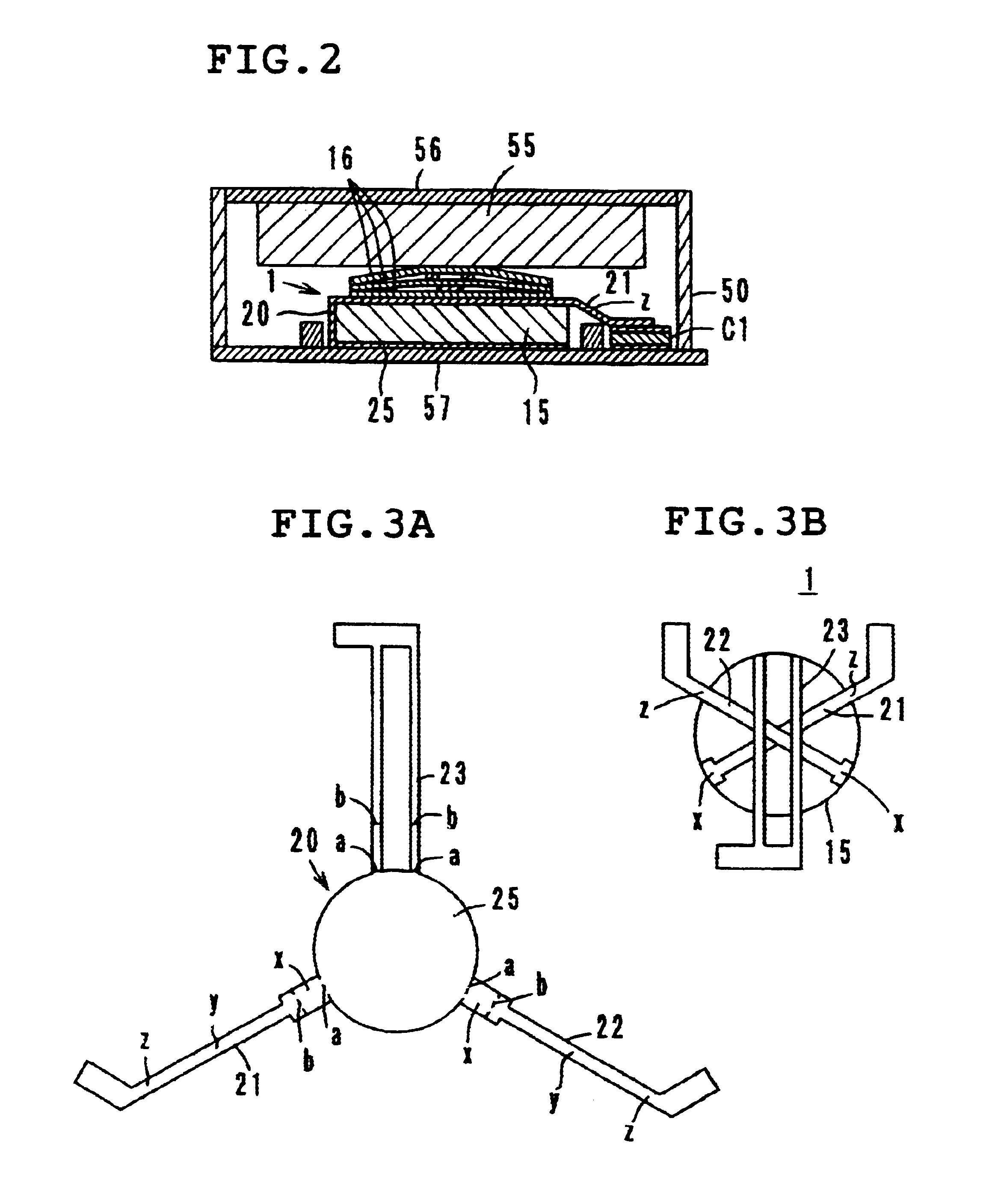Center electrode assembly, nonreciprocal circuit device, and communication apparatus
a technology of center electrode and non-reciprocal circuit, which is applied in the direction of cathode ray tube/electron beam tube, electric discharge tube, instrument, etc., can solve the problems of difficult to form all center electrodes, limit the working accuracy available, and line may break
- Summary
- Abstract
- Description
- Claims
- Application Information
AI Technical Summary
Benefits of technology
Problems solved by technology
Method used
Image
Examples
first embodiment
, FIGS. 1 to 4
FIG. 1 illustrates each of the components of a nonreciprocal circuit device (concentrated-constant type isolator) having a center electrode assembly 1 in accordance with a first embodiment of the present invention, and FIG. 2 is a sectional view showing a state wherein these components have been assembled. FIG. 3A is a development view of an electrode assembly 20, and FIG. 3B is a view showing the center electrode assembly 1. Also, FIG. 4 is the electrical equivalent diagram of the nonreciprocal circuit device.
In this nonreciprocal circuit device, the center electrode assembly 1, which will be detailed below, a permanent magnet 55, matching capacitors C1, C2, and C3, and a resistor element R are accommodated in a resin case 50, and are surrounded by yoke portions, hereinafter referred to as metallic cases 56 and 57, from above and below.
In the resin case 50, a conductor portion for serving as an input / output terminal 51, the capacitor elements C1, C2, and C3, and the r...
second embodiment
, FIGS. 5A and 5B
A center electrode assembly 2 in accordance with a second embodiment of the present invention is configured by making the width of each of the center electrodes 21 and 22, which are each formed of one conductor line, so as to gradually increase (in a so-called reverse-tapered profile) from the center portion y up to the ferrite edge portion x on the cold-end side.
Other configurations of the second embodiment are the same as those of the above-described first embodiment, and the effects thereof also are fundamentally the same as those of the first embodiment. Furthermore, in the second embodiment, since the line width of the center electrodes 21 and 22 constitutes a so-called reverse tapered profile, no step difference occurs at the ferrite edge portion x on the cold-end side. Notably, this allows the stress concentration at the folded portion "b" to be avoided, thereby stabilizing even more the crossing angle formed among the center electrodes 21, 22, and 23 on the ...
third embodiment
, FIGS. 6A and 6B
A center electrode assembly 3 in accordance with a third embodiment is configured by making the width of each of the center electrodes 21 and 22, which are each formed of one conductor line, so as to gradually increase (in a so-called reverse-tapered profile) from the center portion y up to the ferrite edge portion x on the cold-end side, as well as up to the ferrite edge portion z on the hot-end side.
Other configurations of the third embodiment are the same as those of the above-described first and second embodiments, and the effects thereof also are fundamentally the same as those of the first and second embodiments.
In the third embodiment, the ferrite edge portion on the hot-end side z is also formed wide. As shown in FIG. 2, this edge portion z forms an angle of about 45.degree. with the center portion y, and hence, if the line width here were small, the bending angle and bending shape thereof would not be stabilized, and could cause connection defects or line b...
PUM
 Login to View More
Login to View More Abstract
Description
Claims
Application Information
 Login to View More
Login to View More - R&D
- Intellectual Property
- Life Sciences
- Materials
- Tech Scout
- Unparalleled Data Quality
- Higher Quality Content
- 60% Fewer Hallucinations
Browse by: Latest US Patents, China's latest patents, Technical Efficacy Thesaurus, Application Domain, Technology Topic, Popular Technical Reports.
© 2025 PatSnap. All rights reserved.Legal|Privacy policy|Modern Slavery Act Transparency Statement|Sitemap|About US| Contact US: help@patsnap.com



